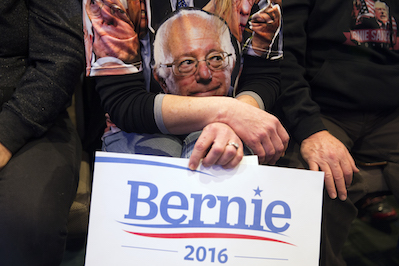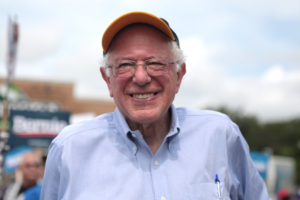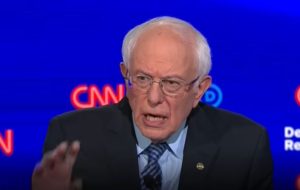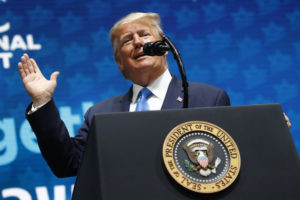Why Bernie Sanders Should Stay in the Race — and How He Can Win
By joining forces with the Green Party's Jill Stein, the Vermont senator would pose a formidable independent challenge to both Donald Trump and Hillary Clinton, two of the major parties' most unpopular candidates in recent history. A Bernie Sanders supporter holds a sign at a campaign rally. (Evan Vucci / AP)
1
2
3
A Bernie Sanders supporter holds a sign at a campaign rally. (Evan Vucci / AP)
1
2
3
New voters, especially young ones, are also likely to be a big factor in the outcome of the election, as a Harvard Institute of Politics poll shows. Jill Stein takes strong positions on college debt and tuition, even stronger than Sanders. She is calling for confronting youth tuition debt, not just the current cost of college. The Sanders-Stein team would excite youth because its agenda would positively impact young people’s lives. While more difficult to reach, even the poor who have been disenfranchised by the two Wall Street parties may even see hope and come out to vote. Finally, Sanders-Stein could unite all the parties on the left, including Green, Socialist and Progressive parties.
Sanders would also do well enough in polling to ensure the duo’s inclusion in the presidential debates. Standing side-by-side with Clinton and Trump would position Sanders well and reach an audience of 60 million. Everything could change with those debates, and the legitimacy of the Sanders-Stein campaign would be solidified. Once people see their potential to win, their numbers would increase. Sanders has already built an impressive national organization of volunteers and donors, and his campaign as a Green Party candidate would be seen as viable by the media and by voters.
The other claim being put forward is that no candidate would get 270 electoral votes and that the Republican-led House of Representatives would then decide the election. History shows this is more fear than reality. As Lawrence Tribe and Thomas Rollins wrote in The Atlantic in 1980 — when there was a similar fear that the Reagan-Carter-Anderson race would leave the decision to the House: “[E]xperience teaches that our fears may be more a product of reflex than reflection.”
There have been many multi-candidate races in American history, but the last time the House decided the outcome was in 1877 — and that was not even because of a multi-candidate race. In fact, the losing candidate won more than 50 percent of the vote. The result got pushed to the House because of fraud. Before that, the House stepped in in 1824, when we had a very different electoral system. Fast-forward to 1992, when Bill Clinton won 40 percent in a three-way race and got 270 electoral votes.
In the unlikely event that nobody received a majority of electoral votes, Clinton and Sanders could negotiate before the Electoral College voted on Dec. 15 and avoid a House decision. Tribe and Rollins wrote that “a candidate might simply persuade the electors chosen to support him on November 4 to cast their ballots for someone else. Indeed, electors could do so on their own, since the Constitution makes them free agents.”
Each candidate could ensure control of how his electors voted by signing a contract with them, as George Wallace did in 1968. Two days before the election, Nixon and Wallace were negotiating on the electors, but then Nixon won the Electoral College and no deal was needed. Imagine what a Sanders-Clinton negotiation could produce.
Sanders and Stein could be a coalition that could not only win a plurality of popular votes in a three-way race but could also win 270 electoral votes. (Here is one possible map of how Sanders could pull it off.)
Their campaign would also bolster the campaigns of progressives who are running for Congress and share the Sanders-Stein agenda; and it would open space for future independent party challenges to the corporate political duopoly.
SUPPORT TRUTHDIG
The Path to Ballot Access Across the Nation
This late in the game, there is only one path to getting on the ballot across the nation, and it cannot be done by running as an independent. Sanders would need to create an alliance with the Green Party, which is currently on 21 ballots (including some of the largest and most difficult states) and is on a path to being on almost all ballots. Twelve states have deadlines for ballot access for independent candidates before the Democratic National Convention, which will take place July 25-28. Some important states are in that group, including Florida, Illinois, Michigan, North Carolina, Texas and Washington. By Aug. 15, 18 more states are due, among them California, Colorado, Ohio and Pennsylvania. Thus, it is impossible for Sanders to run an independent campaign after the Democratic National Convention. But there is an alternative: Jill Stein, the presumptive nominee of the Green Party, wrote to Sanders after the New York primary to discuss “ways they and their campaigns could work together to win a progressive political revolution in the United States.” Stein sought to “have a conversation to explore possible collaboration, in this hour of unprecedented crisis and potential for transformative change.” In an interview with Dennis Trainor Jr., she said she would even be open to running as the vice presidential nominee if Sanders wanted the Green Party presidential nomination. Sanders should meet with Jill Stein to determine where this could lead. Even if Sanders decides not to do anything further, meeting with Stein would strengthen his hand in negotiating with Clinton. The Democrats would then realize that Sanders has somewhere to go other than the Democratic Party, and the alternative path is consistent with his history as the longest-serving independent in the Congress.Electing President Sanders
Those who want to see the Sanders campaign continue through Election Day need to urge Sanders to meet with Jill Stein and to not endorse Clinton. Sanders will only change course if he is pushed from the grass roots. In addition to massive petition, email and social media campaigns, people need to plan to come to the Democratic Convention and protest outside and inside, saying: “No Endorsement for Hillary” and “Sanders, Run Green.” If grass-roots activists succeed in doing so, the 2016 electoral revolution could end with President Sanders in the White House. Patrick Walker, a veteran anti-fracking and Occupy Wall Street activist, is co-founder of Revolt Against Plutocracy and co-creator of the Bernie or Bust pledge, which spawned the nationwide Bernie or Bust movement. This article represents both his personal views and the official standpoint of Revolt Against Plutocracy. Kevin Zeese has worked on multiple Green and independent campaigns, including as spokesman for Ralph Nader in 2004. Zeese is co-director of Popular Resistance, which grew out of the Occupy movement. This article represents his personal views. Your support matters…Independent journalism is under threat and overshadowed by heavily funded mainstream media.
You can help level the playing field. Become a member.
Your tax-deductible contribution keeps us digging beneath the headlines to give you thought-provoking, investigative reporting and analysis that unearths what's really happening- without compromise.
Give today to support our courageous, independent journalists.






You need to be a supporter to comment.
There are currently no responses to this article.
Be the first to respond.